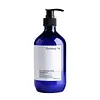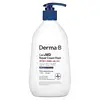What's inside
What's inside
 Key Ingredients
Key Ingredients

 Benefits
Benefits

 Concerns
Concerns

 Ingredients Side-by-side
Ingredients Side-by-side

Water
Skin ConditioningLauryl Glucoside
CleansingDisodium Cocoamphodiacetate
CleansingSodium Chloride
MaskingLauryl Betaine
CleansingGlycerin
HumectantCoco-Betaine
CleansingCitric Acid
BufferingButylene Glycol
HumectantCaprylyl Glycol
EmollientHydroxyacetophenone
AntioxidantPentylene Glycol
Skin ConditioningDipropylene Glycol
HumectantHippophae Rhamnoides Fruit Extract
Skin ConditioningButyrospermum Parkii Butter Extract
Skin ConditioningDisodium EDTA
Ethylhexylglycerin
Skin ConditioningHexylene Glycol
EmulsifyingTocopherol
Antioxidant1,2-Hexanediol
Skin ConditioningCentella Asiatica Extract
CleansingPolyglyceryl-10 Myristate
Skin ConditioningPolygonum Cuspidatum Root Extract
AntioxidantScutellaria Baicalensis Root Extract
AstringentMacadamia Ternifolia Seed Oil
EmollientMineral Salts
Skin ConditioningOlea Europaea Fruit Oil
MaskingLonicera Japonica Flower Extract
Skin ConditioningCamellia Sinensis Leaf Extract
AntimicrobialGlycyrrhiza Uralensis Root Extract
Skin ConditioningHelianthus Annuus Seed Oil
EmollientEthylhexyl Palmitate
EmollientChamomilla Recutita Flower Extract
MaskingCaprylic/Capric Triglyceride
MaskingCetyl Ethylhexanoate
EmollientRosmarinus Officinalis Leaf Extract
AntimicrobialSodium Hyaluronate
HumectantHydrogenated Lecithin
EmulsifyingCeramide NP
Skin ConditioningHydrolyzed Hyaluronic Acid
HumectantHydroxypropyltrimonium Hyaluronate
Sodium Hyaluronate Crosspolymer
HumectantSodium Acetylated Hyaluronate
HumectantWater, Lauryl Glucoside, Disodium Cocoamphodiacetate, Sodium Chloride, Lauryl Betaine, Glycerin, Coco-Betaine, Citric Acid, Butylene Glycol, Caprylyl Glycol, Hydroxyacetophenone, Pentylene Glycol, Dipropylene Glycol, Hippophae Rhamnoides Fruit Extract, Butyrospermum Parkii Butter Extract, Disodium EDTA, Ethylhexylglycerin, Hexylene Glycol, Tocopherol, 1,2-Hexanediol, Centella Asiatica Extract, Polyglyceryl-10 Myristate, Polygonum Cuspidatum Root Extract, Scutellaria Baicalensis Root Extract, Macadamia Ternifolia Seed Oil, Mineral Salts, Olea Europaea Fruit Oil, Lonicera Japonica Flower Extract, Camellia Sinensis Leaf Extract, Glycyrrhiza Uralensis Root Extract, Helianthus Annuus Seed Oil, Ethylhexyl Palmitate, Chamomilla Recutita Flower Extract, Caprylic/Capric Triglyceride, Cetyl Ethylhexanoate, Rosmarinus Officinalis Leaf Extract, Sodium Hyaluronate, Hydrogenated Lecithin, Ceramide NP, Hydrolyzed Hyaluronic Acid, Hydroxypropyltrimonium Hyaluronate, Sodium Hyaluronate Crosspolymer, Sodium Acetylated Hyaluronate
Water
Skin ConditioningSodium Cocoyl Isethionate
CleansingGlycerin
HumectantDisodium Cocoamphodiacetate
CleansingSodium Chloride
MaskingHydroxypropyl Starch Phosphate
Potassium Cocoyl Glycinate
Citric Acid
BufferingCetearyl Olivate
Dipropylene Glycol
Humectant1,2-Hexanediol
Skin ConditioningSorbitan Olivate
EmulsifyingHydroxyacetophenone
AntioxidantPanthenol
Skin ConditioningPolyquaternium-67
Polyquaternium-10
Hexylene Glycol
EmulsifyingDisodium EDTA
Butyrospermum Parkii Butter
Skin ConditioningCaprylamide Mea
AntioxidantVitis Vinifera Seed Oil
EmollientMyristoyl/Palmitoyl Oxostearamide/Arachamide Mea
Skin ConditioningButylene Glycol
HumectantHydrogenated Lecithin
EmulsifyingOlea Europaea Fruit Oil
MaskingGlycolipids
Skin ConditioningCeramide NP
Skin ConditioningCandida Bombicola/Glucose/Methyl Rapeseedate Ferment
AntimicrobialWater, Sodium Cocoyl Isethionate, Glycerin, Disodium Cocoamphodiacetate, Sodium Chloride, Hydroxypropyl Starch Phosphate, Potassium Cocoyl Glycinate, Citric Acid, Cetearyl Olivate, Dipropylene Glycol, 1,2-Hexanediol, Sorbitan Olivate, Hydroxyacetophenone, Panthenol, Polyquaternium-67, Polyquaternium-10, Hexylene Glycol, Disodium EDTA, Butyrospermum Parkii Butter, Caprylamide Mea, Vitis Vinifera Seed Oil, Myristoyl/Palmitoyl Oxostearamide/Arachamide Mea, Butylene Glycol, Hydrogenated Lecithin, Olea Europaea Fruit Oil, Glycolipids, Ceramide NP, Candida Bombicola/Glucose/Methyl Rapeseedate Ferment
Ingredients Explained
These ingredients are found in both products.
Ingredients higher up in an ingredient list are typically present in a larger amount.
1,2-Hexanediol is a synthetic liquid and another multi-functional powerhouse.
It is a:
- Humectant, drawing moisture into the skin
- Emollient, helping to soften skin
- Solvent, dispersing and stabilizing formulas
- Preservative booster, enhancing the antimicrobial activity of other preservatives
Butylene Glycol (or BG) is used within cosmetic products for a few different reasons:
Overall, Butylene Glycol is a safe and well-rounded ingredient that works well with other ingredients.
Though this ingredient works well with most skin types, some people with sensitive skin may experience a reaction such as allergic rashes, closed comedones, or itchiness.
Learn more about Butylene GlycolCeramide NP is a type of ceramide and formally known as ceramide 3.
Ceramides are intercellular lipids naturally found in our skin that bonds dead skin cells together to create a barrier. They are known for their ability to hold water and thus are a great ingredient for dry skin.
Ceramides are an important building block for our skin barrier. A stronger barrier helps the skin look more firm and hydrated. By bolstering the skin ceramides act as a barrier against irritating ingredients. This can help with inflammation as well.
If you would like to eat ceramides, sweet potatoes contain a small amount.
Read more about other common types of ceramides here:
Ceramide AP
Ceramide EOP
Citric Acid is an alpha hydroxy acid (AHA) naturally found in citrus fruits like oranges, lemons, and limes.
Like other AHAs, citric acid can exfoliate skin by breaking down the bonds that hold dead skin cells together. This helps reveal smoother and brighter skin underneath.
However, this exfoliating effect only happens at high concentrations (20%) which can be hard to find in cosmetic products.
Due to this, citric acid is usually included in small amounts as a pH adjuster. This helps keep products slightly more acidic and compatible with skin's natural pH.
In skincare formulas, citric acid can:
While it can provide some skin benefits, research shows lactic acid and glycolic acid are generally more effective and less irritating exfoliants.
Most citric acid used in skincare today is made by fermenting sugars (usually from molasses). This synthetic version is identical to the natural citrus form but easier to stabilize and use in formulations.
Read more about some other popular AHA's here:
Learn more about Citric AcidDipropylene Glycol is a synthetically created humectant, stabilizer, and solvent.
This ingredient helps:
Dipropylene glycol is technically an alcohol, but it belongs to the glycol family (often considered part of the ‘good’ alcohols). This means it is hydrating and gentle on skin unlike drying solvent alcohols like denatured alcohol.
As a masking agent, Dipropylene Glycol can be used to cover the smell of other ingredients. However, it does not have a scent.
Studies show Dipropylene Glycol is considered safe to use in skincare.
Learn more about Dipropylene GlycolDisodium Cocoamphodiacetate is a surfactant and helps cleanse skin. It is created from the fatty acids of coconut oil.
Surfactants help rinse oil, dirt, and other pollutants easily from skin. It has a faint fruit-like scent.
Disodium EDTA plays a role in making products more stable by aiding other preservatives.
It is a chelating agent, meaning it neutralizes metal ions that may be found in a product.
Disodium EDTA is a salt of edetic acid and is found to be safe in cosmetic ingredients.
Learn more about Disodium EDTAGlycerin is already naturally found in your skin. It helps moisturize and protect your skin.
A study from 2016 found glycerin to be more effective as a humectant than AHAs and hyaluronic acid.
As a humectant, it helps the skin stay hydrated by pulling moisture to your skin. The low molecular weight of glycerin allows it to pull moisture into the deeper layers of your skin.
Hydrated skin improves your skin barrier; Your skin barrier helps protect against irritants and bacteria.
Glycerin has also been found to have antimicrobial and antiviral properties. Due to these properties, glycerin is often used in wound and burn treatments.
In cosmetics, glycerin is usually derived from plants such as soybean or palm. However, it can also be sourced from animals, such as tallow or animal fat.
This ingredient is organic, colorless, odorless, and non-toxic.
Glycerin is the name for this ingredient in American English. British English uses Glycerol/Glycerine.
Learn more about GlycerinHexylene Glycol is a surfactant. Glycols are a class of alcohols. Hexylene Glycol is a surfactant and emulsifier.
As a surfactant, Hexylene Glycol helps gather dirt and oil on your skin to be washed away.
As an emulsifier, Hexylene Glycol helps keep water and oil together. This prevents them from separating in a product. Hexylene Glycol also thins out the texture of a product by lessening viscosity.
Hexylene Glycol has a small molecular weight.
Learn more about Hexylene GlycolHydrogenated Lecithin is created from the hydrogenation of lecithin (a group of phospholipids). Hydrogenation is a chemical reaction between hydrogen and another element.
This ingredient is an emollient and emulsifier. As an emollient, it helps soften skin by trapping moisture within. As an emulsifier, it prevents oil and water ingredients from separating.
Hydroxyacetophenone is antioxidant with skin conditioning and soothing properties. It also boosts the efficiency of preservatives.
This ingredient is not irritating or sensitizing.
Olea Europaea Fruit Oil is the fixed oil obtained from the ripe fruit of the Olive. In other words - olive oil.
The primary contents of olive oil are glycerides of the fatty acids linoleic, oleic and palmitic.
Olive oil also contains antioxidants such as Vitamin E. Antioxidants may help reduce signs of aging by fighting unstable free-radical molecules. It also contains Vitamins A (retinol), D, and K.
The squalene in olive oil makes it a great emollient. Emollients help soothe and soften your skin by trapping moisture in. This makes olive oil a great skin moisturizer.
Studies show olive oil to have antibacterial and antifungal properties in low concentrations. Another study found olive oil irritated sensitive oily skin. We always recommend speaking with a professional about using this ingredient in your routine.
Due to the fatty acid content, this ingredient may not be fungal-acne safe.
Learn more about Olea Europaea Fruit OilChances are, you eat sodium chloride every day. Sodium Chloride is also known as table salt.
This ingredient has many purposes in skincare: thickener, emulsifier, and exfoliator.
You'll most likely find this ingredient in cleansers where it is used to create a gel-like texture. As an emulsifier, it also prevents ingredients from separating.
There is much debate on whether this ingredient is comedogenic. The short answer - comedogenic ratings don't tell the whole story. Learn more about comegodenic ratings here.
The concensus about this ingredient causing acne seems to be divided. Research is needed to understand if this ingredient does cause acne.
Scrubs may use salt as the primary exfoliating ingredient.
Learn more about Sodium ChlorideWater. It's the most common cosmetic ingredient of all. You'll usually see it at the top of ingredient lists, meaning that it makes up the largest part of the product.
So why is it so popular? Water most often acts as a solvent - this means that it helps dissolve other ingredients into the formulation.
You'll also recognize water as that liquid we all need to stay alive. If you see this, drink a glass of water. Stay hydrated!
Learn more about Water